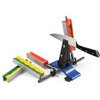I sort of feel like they guy that wants his kids to learn to drive a manual stick shift in case they ever have to. (shoot my Dad would not let me drive the nice auto trans car until I mastered the old station wagon with "Three on the tree")
fact is most cars and light trucks are automatics these days.
There are a lot of tools that make knife sharpening easier for the never got the hang of a manual transmission crowd and there is not a thing wrong with them....except most are leave at home or in the truck things. Not near as handy as a file in the hip pocket and a pocket stone in the front left.
On the other hand most folks today did not have a butcher for a Grand dad that insisted they not use anything but the bench stone for sharpening the shop knives.
When my best bud, who after a couple of years of my teaching still could not sharpen a knife, went out and bought one of those things that clips onto your buck knife to keep the angle right, I was appalled! Guy had an IQ of 140 + but could not hold a knife against a stone and drag it at a decent angle! Imagine my shock when I found out MOST guys in my Infantry outfit did more damage to a knife than sharpening it when they applied steel to stone!
Fact is that knife sharpening which some of us have done with and old brick, a concrete curb, the bottom of a ceramic coffee cup ect. ect. actually is something of an art form.
Finding the right "crutch" can be an expensive outing, though folks sharing on here can be helpful. Me I do not run worth a flip and never had yet I know folks that do 10k fun runs for fun. I can sort of waltz and fake a two step but any other ballroom dancing is beyound me. Juggle? I don't think so. Why would I poke fun at someone that can not sharpen a knife?
Find what works best for you and use it. Don't worry about critics or fashion, just....get'er done!
-kBob









